


Arms and the Church
by
Mike Oettle
Durham / cartouches / Popes/Vatican / Hervormde Kerk / Lutheran / Congregational
COATS OF ARMS came into being as the mark of a warrior. The Church is made up of men of peace. So how did coat-armour find its way into the Church?
In part the answer lies in the political role the Church played in the Middle Ages. During the first three centuries of the Christian era, the Church was a persecuted minority, and its bishops had an often secretive leadership role that played no part in government and was very close to the role laid down for them in Paul’s letters that are found in the New Testament.
But two major changes saw the bishops and patriarchs (chief bishops) thrust into increasingly political spheres. Firstly the Emperor Constantine[1] consulted the bishops and patriarchs, and invited them to convocations (notably the one at Nicea) at which Church doctrine was discussed. Constantine also built a new capital at Constantinople (now Istanbul), which was formally inaugurated in AD330. Gradually a division grew between the eastern and western halves of the empire. Secondly, following the barbarian invasions of the fourth century AD, civil life in the western half of the Roman Empire decayed and the bishops were forced to step in and take part in distributing food to the poor, providing money for building works and, in some places, taking a leading role in government.
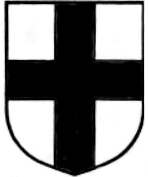


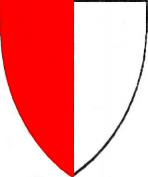
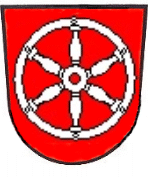
By the time of the Carolingian Empire,[2] it had become routine for a bishop and a count[3] to be sent together as a commission of inquiry into the administration of a district. By this time, also, it had become normal for churches and church institutions to be endowed with land to provide for their upkeep, because of the collapse of the money economy which the Roman Empire had made universal. Donations and legacies by pious magnates enlarged these church holdings, so that vast estates fell under the control of bishops, abbots and other officials of the Church.


The best-known example of this is the holdings of the Bishops of Rome – who during the Dark Age had adopted the title of Pope. Initially this amounted to ducal rule over the environs of Rome itself, known as the Patrimony of St Peter, which the Roman bishops held as early as the 4th century AD. Charlemagne’s father, Pepin III the Short, additionally donated the Marches (i Marche) and Umbria in AD 756. However, the Pope’s claims to this territory were greatly strengthened by a notorious mediæval forgery known as the Donation of Constantine: a document purportedly signed by Constantine the Great, granting the Papacy perpetual lordship over the territories claimed by the See of Rome. The Papal States reached their fullest extent (and included Romagna, close to Venice, as well) under the rule of Pope Julius II (1503-1511).
But in other places, too, bishops also became territorial magnates. Often this was because kings and emperors saw prelates as less threatening than other princes because they were celibate, and so had no sons to succeed them, or daughters to give in marriage.
In 1180 the archdiocese of Cologne was raised to the status of a duchy (Duchy of Westphalia), chiefly because the electoral princes of the Holy Roman Empire felt that the Duchy of Saxony was too powerful and needed trimming. Until the demise of the Empire under Napoleon (and the secularisation of all the Continent’s prince-bishoprics except Rome itself), the archbishop of Cologne was always the Elector who led the selection of a new emperor. Already a century before the See of Cologne became a duchy, Liège (now in Belgium) had acquired a prince-bishop.
(The Papal States did not entirely disappear until the unification of Italy. Between 1798 and 1815 they disappeared into the revolutionary republics of Italy and then the Napoleonic Empire, but were then restored. However, in 1859 the unification process in the peninsula resulted in the loss of the outlying provinces, while Rome itself fell in 1870. The Popes were not in reality sovereign princes again until 1929, when Mussolini’s Lateran Treaty created the Vatican City State, a minute remnant of the former papal principality.)
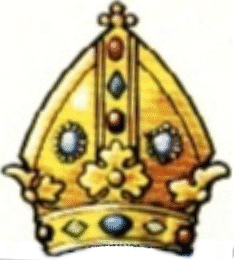
In roughly the same period as the creation of the churchly principalities of Cologne (or Köln) and Liège, the bishopric of Durham, in north-eastern England, became a county palatine – a unique creation in Britain, since this remained the only county palatine in England (Scotland had no equivalent, although the earls of Pembroke, in Wales, were also palatines), and the only ecclesiastical “principality” in the British Isles. (The English kings, unlike their Continental counterparts, were well able to prevent their earls[4] from elevating themselves to sovereign status.) The See of Durham bore responsibility for defence against Scottish invasion. Bishops of Durham wore only the episcopal mitre on their heads, but in their heraldry they combined the mitre with a ducal coronet (or crest-coronet; more about this below).

And in Geneva, when the line of counts died out in 1401, the bishops of that city also acquired the status of count. This disappeared at the Reformation, when in 1536 the last prince-bishop was expelled and a Protestant republic was formed.
Shown at left are the arms of the Counts of Geneva. These were borne among the several quarterings of the Dutch Stadholder William the Silent, and are reflected also in the arms of the (Dutch) Reformed Church of America (click at the bottom of that page to see this in greater detail).
The bishops of Sion ruled what is now the Canton Valais from 999 until 1798, when their territory became part of the Rhodanic Republic. It did not join Switzerland until 1847. The arms of the diocese form the basis of the present-day arms of Valais. Meanwhile the abbots of Sankt Gallen were princes of the Empire from 1206, but their rule was ended by the Reformation in 1524, although their territory only became a canton in 1803. The cantonal arms are revolutionary, but the city of Sankt Gallen still has the abbots’ bear in its arms.
Other prince-bishops were to be found in Utrecht (now in the Netherlands); in Mainz (now in Rhineland-Palatinate); in Metz, Toul and Verdun, in Lorraine[5] (then in the Holy Roman Empire, now in France); Würzburg (in Franconia, now part of Bavaria), whose bishops had ducal authority over eastern Franconia by the 12th century; Salzburg (now in Austria), whose archbishops were princes of the Empire from 1278 onwards; Freising, in Bavaria proper, established as an episcopal seat in AD 739; and Fulda, now in Hessen, seat of an abbey since AD 744, where the abbots acquired the rank of prince-bishop in 1752.
The bishops of Straßburg (now Strasbourg, in France) tried during the Middle Ages to create a prince-bishopric but failed, the city attaining imperial free city status. The bishops of Augsburg, in Bavaria, also did not become prince-bishops, but their influence in the city (an imperial free city from 1276) was such that the city arms copied the episcopal arms. And in Eichstätt (also in Franconia/Bavaria) the bishops did succeed in attaining an ecclesiastical state.
Prince-bishops were not invariably noblemen: the bishop of Mainz who gave that diocese/county its simple coat of arms of a silver wagon-wheel on red was the son of a humble wagon-builder. But priests from the nobility often rose to such eminence, and carried their family coat-armour into ecclesiastical use. And prince-bishops, like their lay counterparts, also bore quarterings for other lordships they held.
So by the time heraldry had become common among the warrior class of Western Europe (the early 12th century), it was also firmly established in the Church, where new rules were made for its application.
Men of the cloth were held to be unfit to wield a sword. But this did not stop many a bishop (called to lead his tenant-troops into battle) from wielding a wicked-looking mace to deadly effect.
All the same, it was held that clerics, not being warriors of the tournament (where the crested helmet played an important ceremonial role), should not include crests in their arms. So instead of a crest, a bishop would display a mitre above his shield. This did not stop some prince-bishops from adding other crests to their display, or even converting the mitre into a crest in its own right, sitting on top of a helmet and accompanied by other symbols more proper to a knight.
The mitres used in heraldry varied as much as those actually used by bishops. The mitre’s upward thrust is meant to symbolise a flame – specifically the flame of the Holy Spirit that appeared on the heads of the disciples in the upper room on the day of Pentecost, as described in Acts 2:3 in the New Testament.
In the early Middle Ages mitres were often quite low, but in the High Middle Ages they grew to a considerable height, possibly in imitation of the combination of a mitre and three crowns worn by the Popes (known technically as a tiara), which was adopted around that time. (See below for two examples of the tiara. This triple crown was abolished by Pope John Paul I, and Pope John Paul II has never worn it personally, although he does display it with his coat of arms.)
Examples of both low and high mitres can be seen on this page: a high one appears on the head of the Bishop of Durham, while the two coats of arms of Lutheran bishops show the low early mediæval style, which in some circles has been revived in modern times.
Mitres in ordinary use in the Roman Catholic Church appear in three styles: the mitra simplex, which is plain white and used on ordinary days of the Church calendar or on occasions when decoration of any kind is avoided; a more decorated variety which is used on slightly more special days; and the mitra pretiosa, or precious mitre, which is highly decorated and embellished with precious stones and metallic thread, and is used on high holy days.
In the Anglican Church, a bishop normally uses just one mitre, or perhaps different mitres appropriate to certain occasions. These are usually neither plain white nor excessively decorated. In the 20th century, makers of mitres have been quite inventive at incorporating motifs reflecting the life of the Church and aspects of the Divine. However, these have had little usage in heraldry.
The mitre is usually accompanied by a pair of tapes or ribbons, technically called lappets or, in Latin, infulæ vitæ. These are traditionally golden, but are often coloured and decorated to match the mitre. In reality the lappets hang behind the bishop’s head when he wears the mitre; in heraldic drawing they are draped artistically alongside the the shield or cartouche (see below), in a manner similar to the ends of the mantling in the arms of a knight displaying a crest.
In the Roman Catholic Church it has since the 19th century been laid down that, unless special permission is given by the Vatican, abbots and suffragan bishops may display only the mitra simplex. Diocesan bishops and archbishops traditionally display the mitra pretiosa. Anglican bishops and dioceses are under no such restrictions, but are usually fairly restrained in their use of decoration.
In England today it is not uncommon for a Church of England cleric to bear arms including a crest; since he is usually married it is probably reckoned that his descendants are entitled to one, therefore why deprive him of the privilege.
The arms of bishops are often accompanied by other symbols (besides a mitre) of their office. Every Roman Catholic and Anglican bishop carries a crosier or crook, in imitation of a shepherd’s crook, since the bishop is expected to carry out Christ’s instruction to Peter to “feed my lambs”. (For more on this quotation, see here.)
Archbishops (at least in the Roman Catholic tradition) use a staff headed by a cross, known as a patriarchal staff. But in Southern and Central Africa at any rate, Anglican archbishops normally prefer to retain the crosier they used when first ordained bishop. The arms of Bishop Helge Fosseus below show only a crosier, while those of Bishop Dr Bengt Sundkler show both a crosier and a patriarchal staff.
The crosses on such staffs vary considerably, ranging from the severe yet heraldic cross formy (as in Dr Sundkler’s below) to quite large crosses. Especially in the Greek Orthodox Church, the large patriarchal cross is accompanied by a “title” – a representation of the scroll that Pontius Pilate had added to Christ’s cross stating in three languages: “Jesus of Nazareth, King of the Jews”.
The title, frequently inscribed INRI (the Latin initials of that inscription), is frequently so large that it looks like a second cross-member. Greek Patriarchs sometimes display a cross that actually has a second cross-member in addition to the title. These usages have given rise to the heraldic device called a cross patriarchal (appearing in a variety of heraldic styles), which does in fact have a second, sometimes even a third, cross-member.

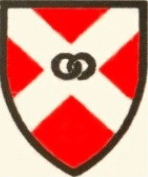
Mention of marriage brings up one of the most interesting heraldic practices connected with the Church, one which has found its way back into the secular world. It was held that, being celibate, a bishop could only be married to his diocese (or any other priest to the office he held). So a bishop would, especially in England, combine the arms of his diocese with his own family coat of arms in the same way that the arms of a man and wife would be combined: by impalement.
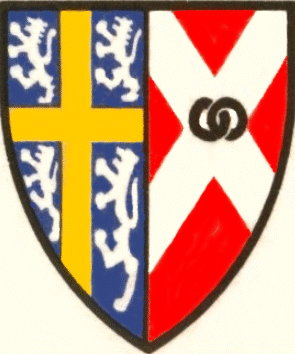
This meant that the shield (or cartouche – see below) was divided per pale, or down the middle, with the arms of the diocese on the dexter side and the bishop’s personal arms on the sinister side. It applied to other offices, too, so a rector or vicar’s arms could be impaled with the arms of the parish, a dean’s with those of the cathedral, an abbot’s with his abbey’s, and so on. For further examples of impalement see here, and for other combinations of arms of office with personal arms, see here.

In England the mitre-and-coronet combination of the bishops of Durham is unique, although widely misunderstood. The diocese lost its county palatine status some two centuries ago, yet 20th-century bishops have continued to display the coronet, and in other dioceses misguided individuals have wrongly displayed the local bishop’s arms ensigned by a mitre plus coronet (for which there is no precedent or authority).
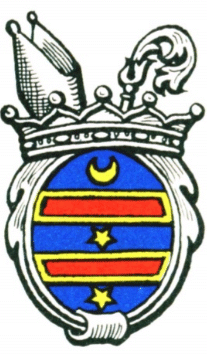
It was also held by some experts that a priest, not being a warrior, should not even bear arms on a shield, and prescribed the oval-shaped cartouche for this usage. Shown here (on a cartouche) are the arms of St Francis de Sales (1567-1622), titular Bishop of Geneva (1602-1622), patron saint of writers. (Following the expulsion of the last prince-bishop from the city of Geneva, the title had continued in use in exile in the Duchy of Savoy.)
(The cartouche serves other purposes, too, however. On the Continent the cartouche is often used to display the arms of a lady. See this article for a discussion of this.)
In the Roman Catholic Church an elaborate system of gradation between clerics evolved, with hats of different colours (displayed above the shield/cartouche, and above the mitre if the armiger was a bishop or abbot) and varying numbers of tassels that hang on either side of the shield or cartouche. The highest-ranking prelates below the Pope himself were the cardinals, with their red hats and tassels.
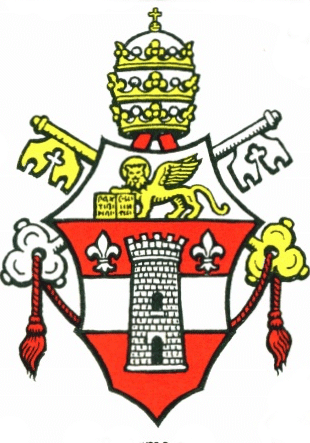


The papacy itself has never used a coat of arms of its own. Instead, each pope places his personal arms (those of his family, if it has arms, or a coat of his own devising, if the family is not armigerous) on a shield supported by crossed keys, symbolising the keys to heaven which Christ promised to St Peter, who in turn is regarded in Catholic tradition as having been the first bishop of Rome. The shield is ensigned by the tiara. The Holy See – as distinct from the papacy – does, however, use a coat of arms (especially since becoming the Vatican State in 1929), in which the crossed keys are placed below a tiara on a red shield. For more on this subject, see this page.
(Incidentally, the papal arms shown at left here are also examples of an Italian oddity: the shield shape derived from a horse’s face-armour. Shields of this shape are common in Italy, but rarely if ever encountered in other countries.)
In addition to the intricate and complex system of heraldry relating directly to the Roman Catholic Church, and until very recently controlled from the Vatican, there is a whole range of heraldic devices appearing in family coats of arms which relate to the Church, many of them specifically to the Papacy, but they will not be covered here since they have little bearing on South Africa.
The Reformation saw the overthrow of much of this system, with especially Reformed (Calvinist) churches often avoiding heraldry altogether, or adopting seals (heraldic or otherwise) only for their synodal authorities, not for individual local churches. But British (Anglican) bishops and their Lutheran counterparts in Germany and Scandinavia continued the heraldic tradition.
It is worth noting, however, that the Church of Scotland (which is Presbyterian/Calvinist) has not only retained a heraldic tradition but has adopted a system of black clerical hats with varying numbers of tassels, similar to those of the Roman church.
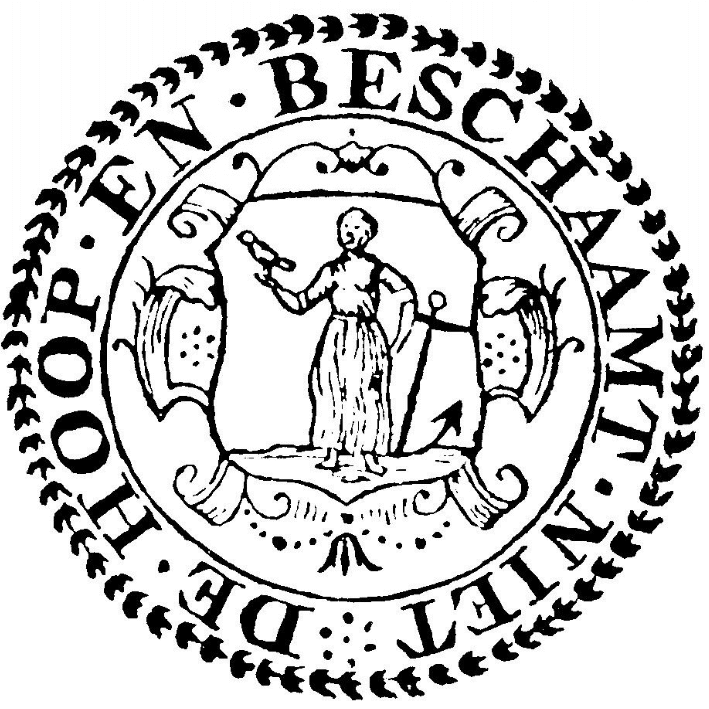
In South Africa, this process could almost be said to have been followed in reverse, since the first church to be established at the Cape was a Dutch Reformed one. The congregation of what is now called the Groote Kerk had its own heraldic seal, but the arms so displayed do not appear to have been executed in colour. The modern seals of the various Nederduitse Gereformeerde Kerk (or Verenigende Gereformeerde Kerk) synods are not heraldic at all.
And while bishops could be relied on to introduce heraldry of some kind, there weren’t any until as late as the 1830s, when the first Roman Catholic bishop of Cape Town was installed, and the 1840s, when the Anglican Church saw the arrival of its first bishop of Cape Town.
Churches initially arrived in South Africa under State auspices. The Nederduitsche Gereformeerde Kerk was the official church of the Dutch colony, and retained that status alongside the Anglican Church under British rule. But in 1875 the concept of a State church finally fell away in the Cape Colony when State subsidies were withdrawn, and churches had to rely on their own members’ contributions.
Ironically, at about the time the trend against State churches began in the 1850s, the Zuid Afrikaansche Republiek adopted the Nederduitsch Hervormde Kerk (a conservative offshoot of the NG Kerk) as its State church. This status fell away when the ZAR was annexed as the Transvaal Colony. However, churches in this country have for the most part been voluntary organisations, and there has never been anything remotely equivalent in South Africa to the mediæval prince-bishoprics.

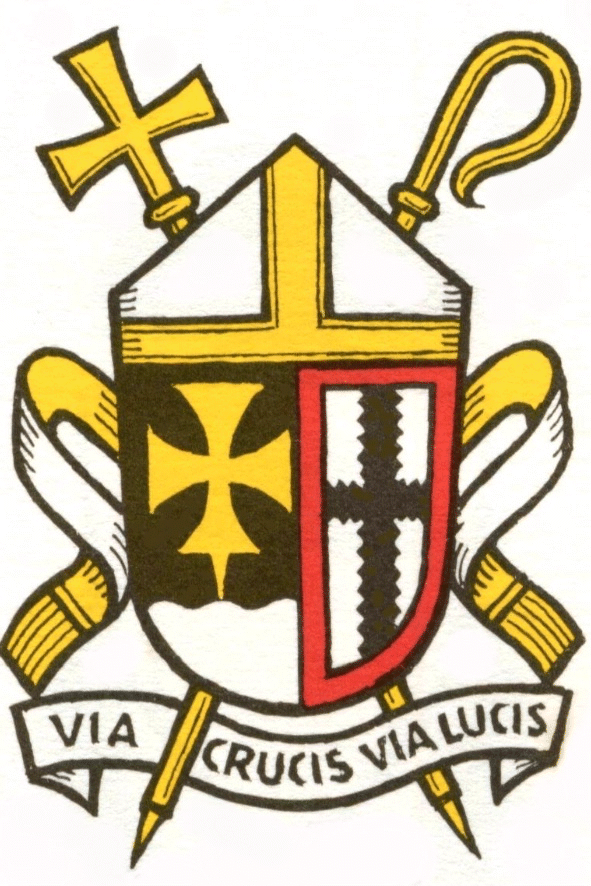
The Anglican dioceses appear to have been the main forces in establishing a permanent heraldic usage, in that the dioceses themselves have had coats of arms which continue in use from one bishop to the next. The Roman Catholics seem to prefer to leave it up to each new bishop to draw up his own arms (if his family is not already armigerous), which makes for an interesting assortment, but not so much continuity. However, the Roman Catholic archdioceses do have their own arms in addition to those of their archbishops.
Parishes, too, have borne arms since the 19th century, but so far not many of them have done so. Brownell’s book[6] lists the arms of only two Anglican parishes (one of which, St Mary’s in Port Elizabeth, has since become a cathedral parish) and notes that a third has an application pending (that of All Saints’, Kabega Park).
So it seems that it will be some time before an innovation introduced by the Canadian Heraldic Authority will be needed in South Africa, where the arms of cathedral parishes are supported by an episcopal cathedra, or chair.[7]
Lutheran bishops of various origins have also used coat-armour in Southern Africa and elsewhere in Africa. Shown at left the arms of Helge Fosseus, Swedish bishop of the Evangelical Lutheran Church in Southern Africa. Aside from being impaled (as in the example of the Durham arms above) these arms also appear on a Nguni shield, as also seen in the arms of KwaZulu, Ciskei, KwaZulu-Natal and Gauteng. At right are the arms of Dr Bengt Sundkler, Bishop of Bokuba in the Swedish Evangelical Church of North-West Tanganyika, which also is impaled.


The United Congregational Church of South Africa has a coat of arms – being broadly in the Calvinist tradition, it, too, only has a single device for a synodal body – and the Presbyterian Church of South Africa had a coat of arms borrowed from the Church of Scotland. However, the Uniting Presbyterian Church of South Africa chose to adopt a completely non-heraldic logo. (Again, these are the property of the synodal body.)

